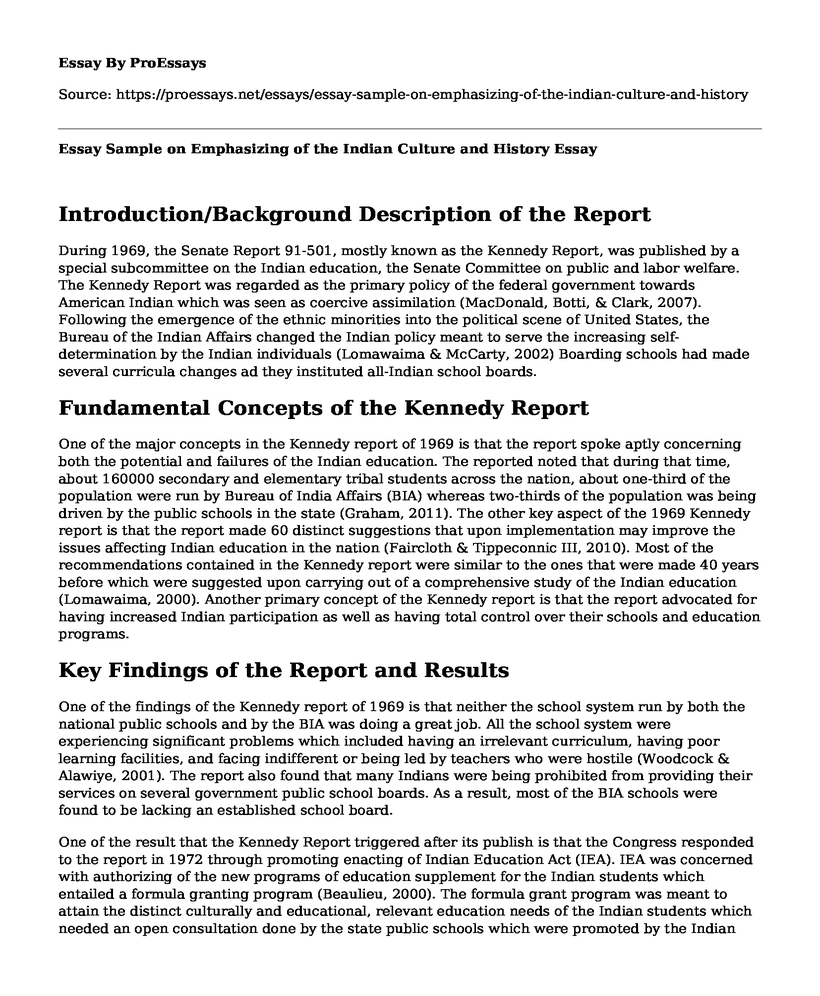Introduction/Background Description of the Report
During 1969, the Senate Report 91-501, mostly known as the Kennedy Report, was published by a special subcommittee on the Indian education, the Senate Committee on public and labor welfare. The Kennedy Report was regarded as the primary policy of the federal government towards American Indian which was seen as coercive assimilation (MacDonald, Botti, & Clark, 2007). Following the emergence of the ethnic minorities into the political scene of United States, the Bureau of the Indian Affairs changed the Indian policy meant to serve the increasing self-determination by the Indian individuals (Lomawaima & McCarty, 2002) Boarding schools had made several curricula changes ad they instituted all-Indian school boards.
Fundamental Concepts of the Kennedy Report
One of the major concepts in the Kennedy report of 1969 is that the report spoke aptly concerning both the potential and failures of the Indian education. The reported noted that during that time, about 160000 secondary and elementary tribal students across the nation, about one-third of the population were run by Bureau of India Affairs (BIA) whereas two-thirds of the population was being driven by the public schools in the state (Graham, 2011). The other key aspect of the 1969 Kennedy report is that the report made 60 distinct suggestions that upon implementation may improve the issues affecting Indian education in the nation (Faircloth & Tippeconnic III, 2010). Most of the recommendations contained in the Kennedy report were similar to the ones that were made 40 years before which were suggested upon carrying out of a comprehensive study of the Indian education (Lomawaima, 2000). Another primary concept of the Kennedy report is that the report advocated for having increased Indian participation as well as having total control over their schools and education programs.
Key Findings of the Report and Results
One of the findings of the Kennedy report of 1969 is that neither the school system run by both the national public schools and by the BIA was doing a great job. All the school system were experiencing significant problems which included having an irrelevant curriculum, having poor learning facilities, and facing indifferent or being led by teachers who were hostile (Woodcock & Alawiye, 2001). The report also found that many Indians were being prohibited from providing their services on several government public school boards. As a result, most of the BIA schools were found to be lacking an established school board.
One of the result that the Kennedy Report triggered after its publish is that the Congress responded to the report in 1972 through promoting enacting of Indian Education Act (IEA). IEA was concerned with authorizing of the new programs of education supplement for the Indian students which entailed a formula granting program (Beaulieu, 2000). The formula grant program was meant to attain the distinct culturally and educational, relevant education needs of the Indian students which needed an open consultation done by the state public schools which were promoted by the Indian parents. The formula grant program greatly assisted the tribal students in getting the quality education that was free from discrimination (Skrentny, 2009).
Conclusion
In conclusion, the Kennedy report of 1969 stated that the national policies meant for providing education to the American Indians had failed in significant proportions. The Kennedy report blamed the efforts made to force all American Indians to start accepting their cultural values which led to increased cases of school dropout among the Indian children. The Kennedy report offered 60 recommendations that would be used in enhancing Indian education that included making emphasize of the Indian culture and history as well as increasing of the funding of the existing programs.
References
Beaulieu, D. L. (2000). Comprehensive reform and American Indian education. Journal of American Indian Education, 39(2), 29-38.
Faircloth, S. C., & Tippeconnic III, J. W. (2010). The dropout/graduation crisis among American Indian and Alaska Native students.
Graham, H. D. (2011). The uncertain triumph: Federal education policy in the Kennedy and Johnson years. UNC Press Books.
Lomawaima, K. T. (2000). Tribal sovereigns: Reframing research in American Indian education. Harvard Educational Review, 70(1), 1-23.
Lomawaima, K. T., & McCarty, T. L. (2002). When tribal sovereignty challenges democracy: American Indian education and the democratic ideal. American Educational Research Journal, 39(2), 279-305.
MacDonald, V. M., Botti, J., & Clark, L. H. (2007). From visibility to autonomy: Latinos and higher education in the US, 1965-2005. Harvard Educational Review, 77(4), 474-504.
Skrentny, J. D. (2009). The minority rights revolution. Harvard University Press.
Woodcock, D. B., & Alawiye, O. (2001). The antecedents of failure and emerging hope: American Indians & public higher education. Education, 121(4), 810.
Cite this page
Essay Sample on Emphasizing of the Indian Culture and History. (2022, Nov 02). Retrieved from https://proessays.net/essays/essay-sample-on-emphasizing-of-the-indian-culture-and-history
If you are the original author of this essay and no longer wish to have it published on the ProEssays website, please click below to request its removal:
- Research Paper on Computer Assisted Learning Language
- Essay on Transitioning to Parenthood
- Stance Essay Example: Media and Young Minds
- Intelligence Tests in Schools Paper Example
- Essay Example on Writing a Cultural Autobiography: Exploring Your Life Story
- Essay on Teachers and Students: Building a Caring Relationship in Childcare Centers
- Essay Example on Human Development







